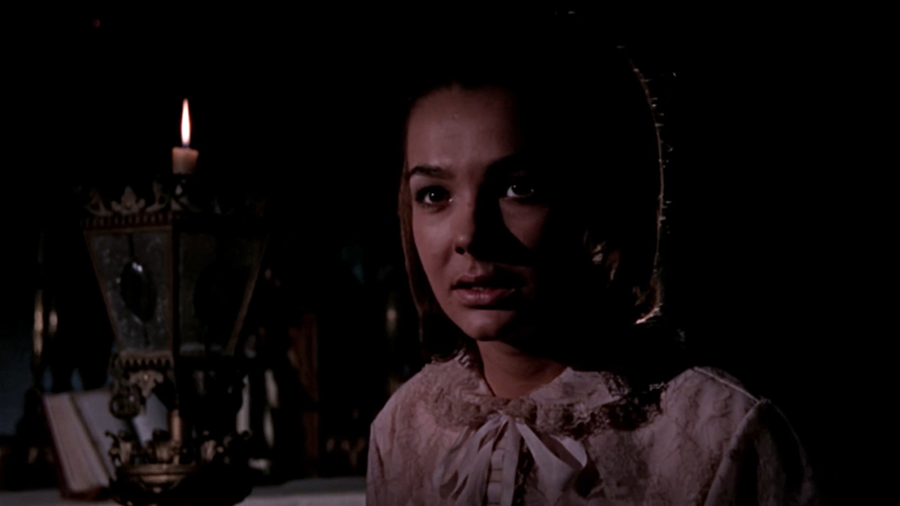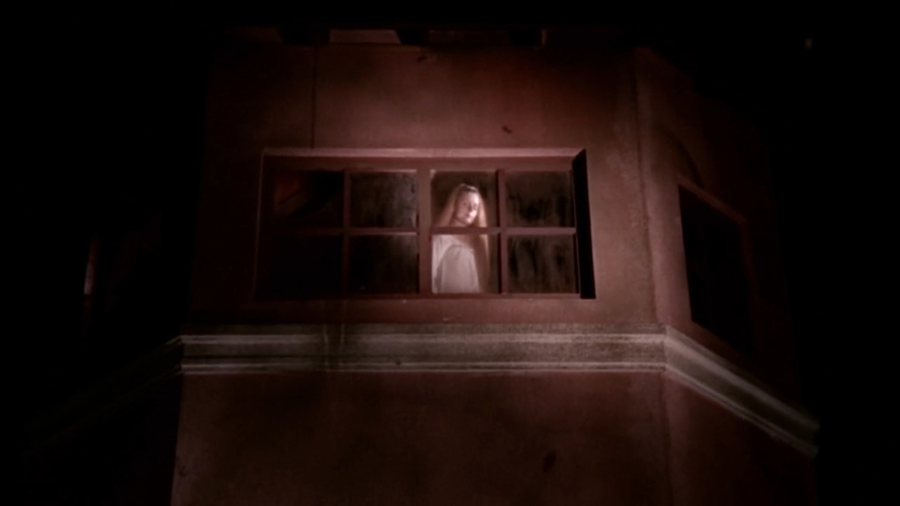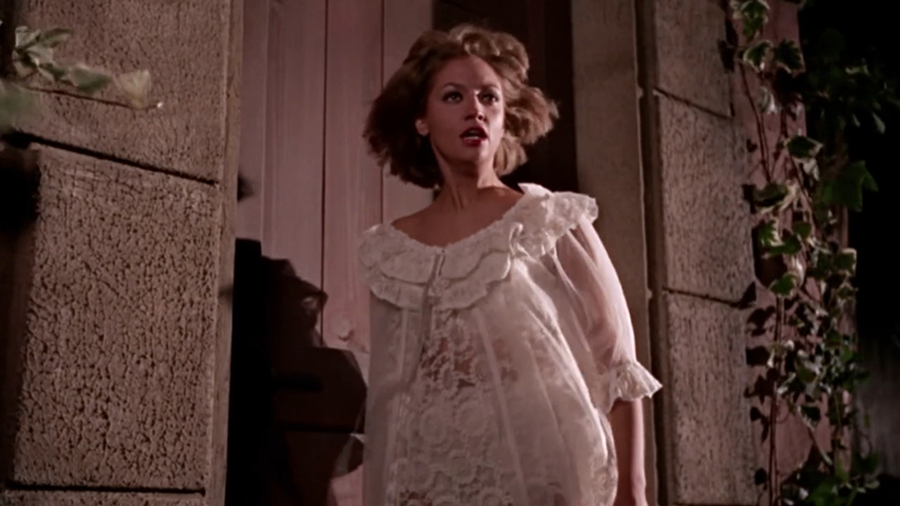EVEN THE WIND IS AFRAID
Directed by Carlos Enrique Taboada. 1968. Mexico.

Claudia has been having a recurring nightmare. In it, she stands at the bottom of a long staircase and hears someone calling to her from an upstairs room. Climbing the stairs, she comes across a red door locked with an iron bar. Behind the door, hanging from the rafters, is a young woman, dead. Claudia’s classmates at the all-girls boarding school she’s attending don’t think much of it. That is, until they discover the large padlock on the tower in the school grounds mysteriously unlocked. As they enter the tower, Claudia realizes that this is the place from her dreams. None of her friends believe her. At least, not until they climb a bit higher. All doubt vanishes when the girls come to a red door locked by an iron bar.
A voice calls out to them. It belongs to the headmistress, Ms. Bernarda. Furious that the girls were exploring the off-limits tower, she grounds them all. While their classmates will go on a ten-day vacation at home, our cast of characters will be staying at school. The assistant headmistress, Lucia, protests, but to no avail. The girls need punishing for disobeying, and that is that. Kitty is especially distraught by this news as she was to meet her boyfriend, Armando, during vacation. Another girl, Josefina, was not part of the group that climbed the tower (she’s a bit of a teacher’s pet), but she stays behind too, only because she has no family to return to.
The next night, Claudia sleepwalks to the tower. Kitty and Ivette chase after her, waking her up. They run back to their dorm room after spotting a long-haired girl watching them from the attic window of the tower. The trio informs the rest of the group (Marina, Silvia, and Veronica) of what they saw. The next day, while retrieving a confiscated picture of her boyfriend, Kitty finds an old photograph of the girl they saw in the attic window inside Ms. Bernarda’s desk. They ask Ms. Lucia about the girl in the photograph. She tells them that her name was Andrea.

Andrea was a model student, skilled at piano, and diligent in her studies. But like our girls, she too felt the wrath of Ms. Bernarda. Andrea was forbidden to leave the school to visit her sick mother. Upon learning that her mother had succumbed to her illness, Andrea climbed the tower and hanged herself. That was five years ago. Soon, Ms. Lucia and the groundskeeper will see the ghost of Andrea. Once again, Claudia sleepwalks to the tower and climbs the stairs. Finding Andrea dangling from the rafters, Claudia staggers backwards and breaks through a railing, falling to her death. They place her body inside the chapel. The girls return to their rooms while Ms. Bernarda stays behind to pray.
But then something inexplicable happens. Claudia awakens, unharmed and aware. But something is off about her. She is suddenly quite skilled at the piano, and her classwork has improved. She even remembers things she has no business remembering. Is she still Claudia? Or has someone else taken up residence inside her body?
That takes us up to a little over halfway through Carlos Enrique Taboada’s stunning 1968 Mexican Gothic chiller, EVEN THE WIND IS AFRAID. To call this film a success is a bit of an understatement. I cannot for the life of me figure out why this isn’t more well-known than it is, or why it isn’t as routinely praised as other well-measured and immaculately constructed ghost stories like THE INNOCENTS or THE UNINVITED. It has the same kind of saturating dread as KILL, BABY… KILL! and Wise’s THE HAUNTING, draped in beautiful cinematography, expressive lighting, and genius shadowplay.
It’s also refreshingly free from most of the worst cliches that would become commonplace over the next couple of decades. Despite our cast of main characters all being schoolgirls, there are no bitchy cliques or petty catfights. Sure, Josefina, in particular, gets teased a bit by the other girls, but she’s a frickin’ narc, so that’s to be expected. But even then, the other girls quickly rush to her defense. It’s only natural she would cling tightly to Ms. Bernarda’s attention. After all, she has no mother of her own.

Maternal issues, parental abandonment, repressed sexuality, and stringent Catholic moral codes are all over this film, and the subtle rebellions are all wonderful to watch. The actresses might not look like teenagers, but they all exude an air of innocence and naivety. They feel genuine and thoughtful, and the camaraderie is palpable and refreshing. When the girls return to the dorm room and tell the others that they saw a ghost, there’s no bickering. When one of the girls expresses fear or hurt, the others offer support. None of the drama comes from their interactions. It’s all generated from the haunting happening around them and, of course, from the headmistress.
But even Ms. Bernardo, the queen bitch herself, is not some one-note villain. She isn’t Miss Trunchbull. You get the impression that she, too, has mommy issues. She treats the girls harshly because it will prepare them for a harsh world, not because she doesn’t care. Ms. Lucia provides the perfect counterbalance. She is kinder, more curious, and more accepting, even going so far as to lie to Ms. Bernardo to keep the girls out of trouble. This duality of mother roles and the twinned experiences of Claudia and Andrea provide EVEN THE WIND IS AFRAID with its thematic oomph. The ending of the film packs a subtle punch, not quite as gut-wrenching as THE WOMAN IN BLACK, but one that sends the film off with a spine-tingling chill.
EVEN THE WIND IS AFRAID is not showy or action-packed. There are no chase scenes here. What good could that possibly do anyway? You cannot outrun the past. There are no jump scares either. Andrea isn't some prankster spirit tossing glasses around or slamming doors. She's barely on-screen but always present. Andrea's haunting permeates every inch of the school. She is felt not just in the tower where she took her life, but in the daily existence of our lead characters, in their regrets, repressions, and their need for compassion and companionship. There is an undenable air of sadness running through the film. Yes, it is a tale of revenge, and yes, it has no qualms with scaring the hell out of you, but a good ghost story is often as much about tragedy as it is horror. EVEN THE WIND IS AFRAID excels at both.